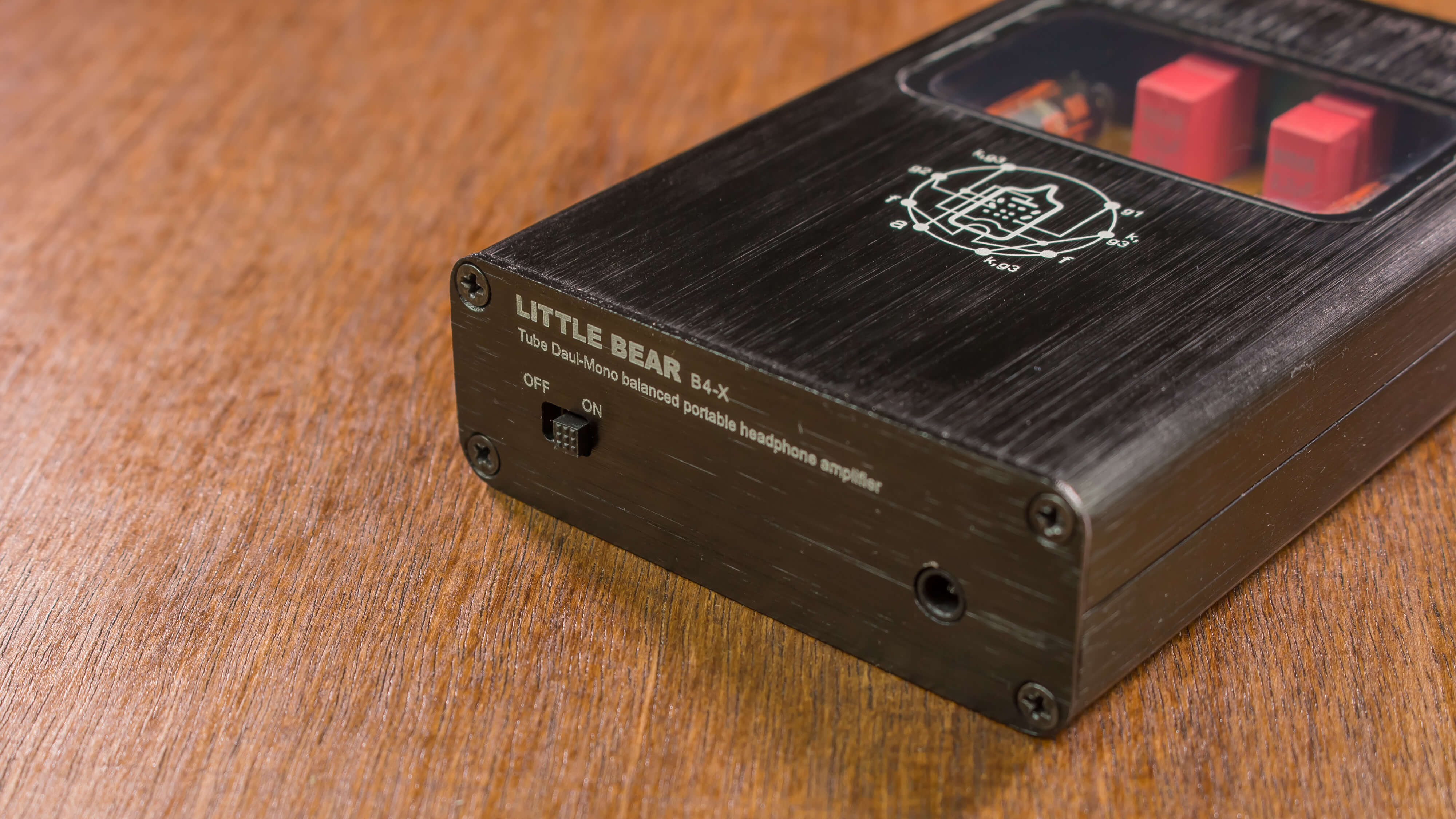
Specs
- Output power : 450mW
- Battery : 12V, 1000mAh
- SNR : 105 dB
- Outputs : 3.5mm single ended / 2.5mm balanced
What’s In The Box?
- Little Bear B4-X
- AC power supply
- 3.5mm interconnect
- 2x rubber bands
Design

The thing about the B4-X that I find rather charming is that sort of retro DIY flair. You can tell this isn’t produced under the tightest of quality control by a large, well-established company. The casing doesn’t look or feel cheap, but it definitely doesn’t have the precision-designed and machined look and feel that you’d expect from some of the bigger companies.It reminds me somewhat of the original FiiO X3 player and E12 amplifier which were both released around 6 years ago, if not more.

But, underneath this almost-all-black colour-scheme and brushed metal finish lies no simple solid-state portable amplifier, and this is revealed by the large viewing-window which allows you to marvel at the warm glow of the 2 miniature RAYTHEON JAN5899 vacuum tubes.This isn’t a full-on tube amp, though. Proper tube amps are pretty inefficient as far as power usage goes, so that’s something that wouldn’t really be suitable in a battery-powered device.
As such, these little tubes are being used as a buffer.
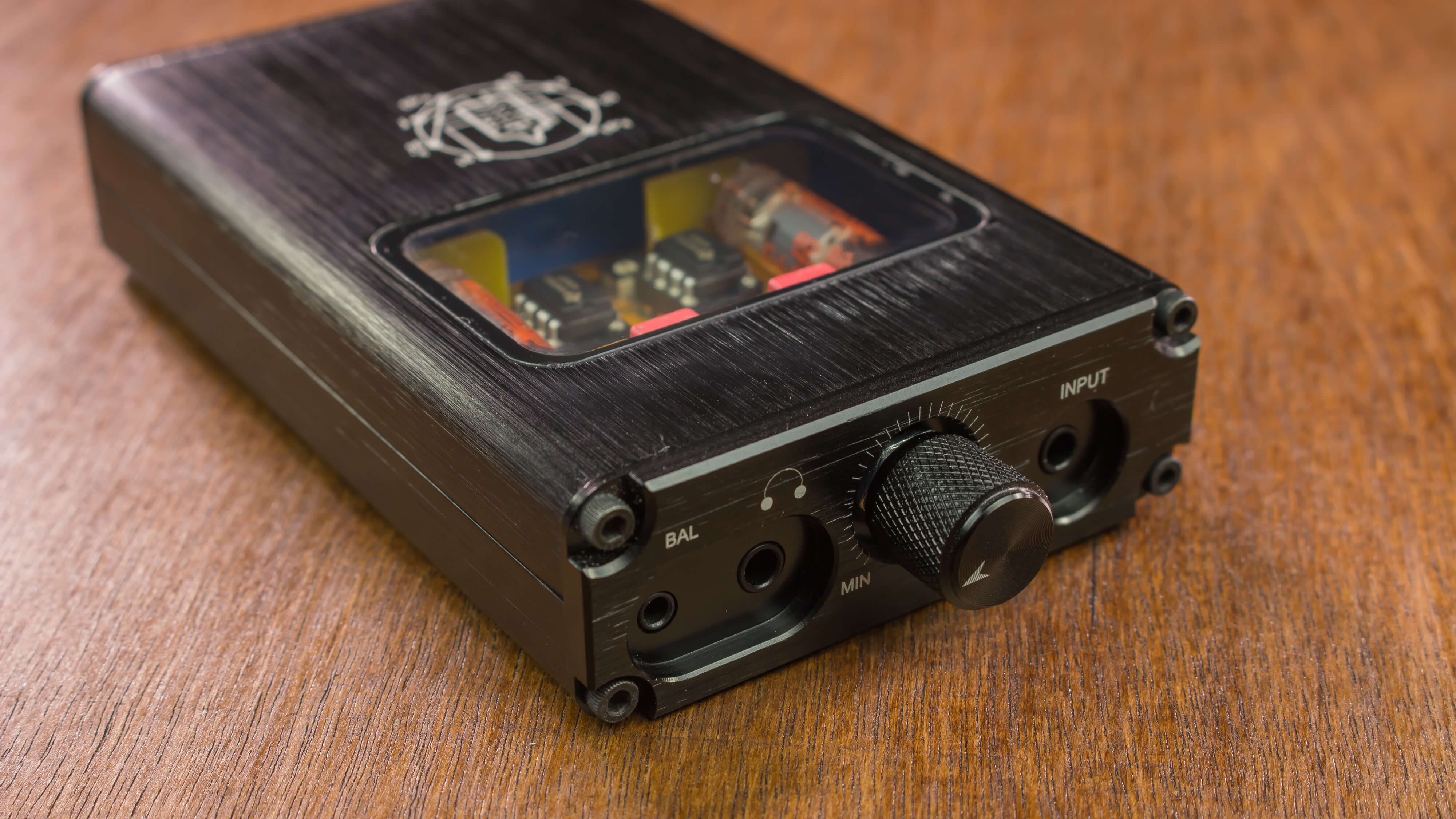
It’s a bit like using the iTube 2 from iFi in your audio chain. You’d place the iTube 2 between the DAC and amplifier or between the DAC and a set of powered speakers, but in the case of the B4-X it’s all just been shrunk-down and placed in a compact package.
The front, or perhaps top panel is where we find the 2.5mm balanced output, as well as both the single-ended 3.5mm output and input. Right between the single-ended connections is a very nice and smooth analogue volume-pot.


Over on the complete opposite end is the power-switch and the power connector for the external charger. You might notice here that there is no sort of USB connector, and that’s because the B4-X has neither a DAC functionality, nor can you charge the internal battery with anything other than the provided wall-charger.
One of the quirkier additions to the design is this printed diagram of a vacuum tube. I have no idea how accurate it is, but it kinda looks cool nonetheless.
Overall the B4-X is a bit of a chunky device, but Douk Audio does make a more compact model which is called the B5.
The B5 costs almost half of what the B4-X does and is a little narrower and thinner, but it also has no balanced output, a lower SNR figure, and only about a 1/6th of the power-output. According to Douk Audio, the B5 apparently has a more durable construction, but at the same time it’s also more susceptible to microphonics and the circuitry does not allow you to swap out the op-amp chip.
In contrast, the B4-X is more DIY friendly as the through-hole circuitry gives you complete access to remove various resistors and capacitors if you wish to do so. This of course assumes that you know what you are doing and that you’d replace those parts with only the correct upgrades or suitable replacements.
The 2 op-amp chips can also be swapped so you can pretty easily upgrade the sound quality with a better-spec’d set.
But, unlike the previous Little Bear B4, the B4-X requires 2 dual op-amp chips rather than just one because of the newly designed circuit layout to incorporate the balanced output.
I did ask Douk Audio which op-amps they would suggest and they recommended that the OPA2604 is the upgraded version of the NE5532P which is already installed.
If you wanted a bit more vocal emphasis, they recommend the DY649, whereas the AD712 is apparently more analytical-sounding.
Then there’s also the OPA627 which they say is more “comprehensive”. I’m not quite sure what they mean by that, but my best guess would be that they mean it has perhaps a more balanced signature.
If you want to really splash some cash on an upgrade you could opt for a pair of dual Burson Audio V5i chips which will set you back $69 excluding shipping and/or applicable taxes.
Overall, I think the design of the B4-X is adequate for the type of device it is and the price-point it hits. And again, there’s just that bit of a retro charm that I really love.
Sound
Now, let’s face it, there is no point in getting a tube-based audio device if what you’re looking for is objective signal accuracy. The whole point of placing vacuum tubes in the audio chain is to add a bit of that warmth and nostalgic magic that tubes are so famous for.
Now, as a reviewer, I have to pick my words carefully, and I always try to explain my point of view in such a manner that whoever reads my articles or watches my reviews are on the same page and understand exactly what it is that I’m trying to say.
So when we talk about the ‘magic of tubes’, what do we actually mean?
Well, make no mistake, we are talking about intentionally adding distortion to the audio signal. But distortion, by definition, is bad for fidelity, right? In most cases, I’d totally agree with you.
But, when it comes to vacuum tubes in the audio chain, what is perhaps equally important to consider is the type of distortion.
When I reviewed the iFi Micro iTube 2 I briefly covered how iFi describes the different sound signatures of the various tube settings and a little bit of how it is achieved. Basically, the difference in sound comes down to things like the circuit topology and the type of tubes used. But for the purpose of this review there are 2 things we want to take into account here, and that is even and odd order harmonics.
Let’s say that we’ve got a signal of 1kHz, in that instance the even order harmonics would be the even multiples of that fundamental tone. So, for this example 2kHz, 4kHz, and 8kHz would be even order harmonics of the fundamental and they are fine in terms of harmonic distortion because they are perfect octaves of that fundamental tone, and they tend to add a sense of warmth and fullness to the sound. Although that 8kHz point can be problematic for other reasons.
But then you also get odd order harmonics which would be something like 3kHz and 5kHz in this case, and the problem with these are that they clash musically with natural notes.
It should also be mentioned that as you move up into higher order of harmonics, those tend to be less desirable. Low-level even order harmonics are the ones we want.
But why would we want to intentionally add distortion? I guess the only way I could describe it would be to use the same example I did in my iTube 2 review about Vaseline on a camera lens.
Way, way back in the day of the movie sets they would often add just a very thin layer of Vaseline or other type of petroleum jelly to the camera lens to soften up the image. This was done entirely for an aesthetic purpose to give the film or image a more dreamy kind of look. This was, of course, a less accurate capturing of the scene, but the whole purpose was for it to be more subjectively pleasant, not more accurate.
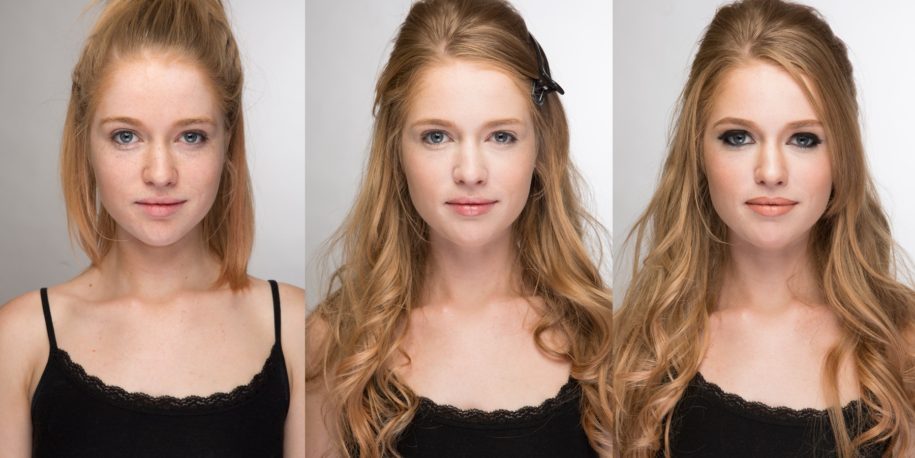
If the Vaseline on the lens idea isn’t an example that makes sense to you, then perhaps just think of a woman wearing a bit of makeup. With no make up at all she might already look very attractive, but add the right amount of eye-liner, blush, and lipstick and she would almost certainly look even more pleasing to the eye. I don’t know if this is a matter of the increased amount of colour and contrast that simply appeals more to the primitive parts of our brains – but whatever the case is, the fact is that it works.
So, with that new look you’re getting a less accurate representation of her true facial features, but if the slightly distorted representation is a more pleasing one…well then that’s entirely the point of doing it in the first place, isn’t it?
That’s basically how I would sum up what it is that tube amplifiers do to the audio. It tends to just soften and warm it up.
And that’s exactly what I’m getting from the B4-X. When I switch back and forth between it and the headphone output of my Micro iDSD Black Label, I can clearly hear that the Black Label sounds cleaner, but the sound I’m getting from the Little Bear just has that touch of warmth and fullness that I find more natural-sounding, and ultimately more pleasing.
The only thing that can be a bit annoying is if you bump the amp then that vibration travels into the tubes and you hear a very distinct ringing sound. This also happens every time you plug your headphones in. The tubes are also susceptible to radio interference, so it’s best to keep it around a foot or more away from a mobile phone.
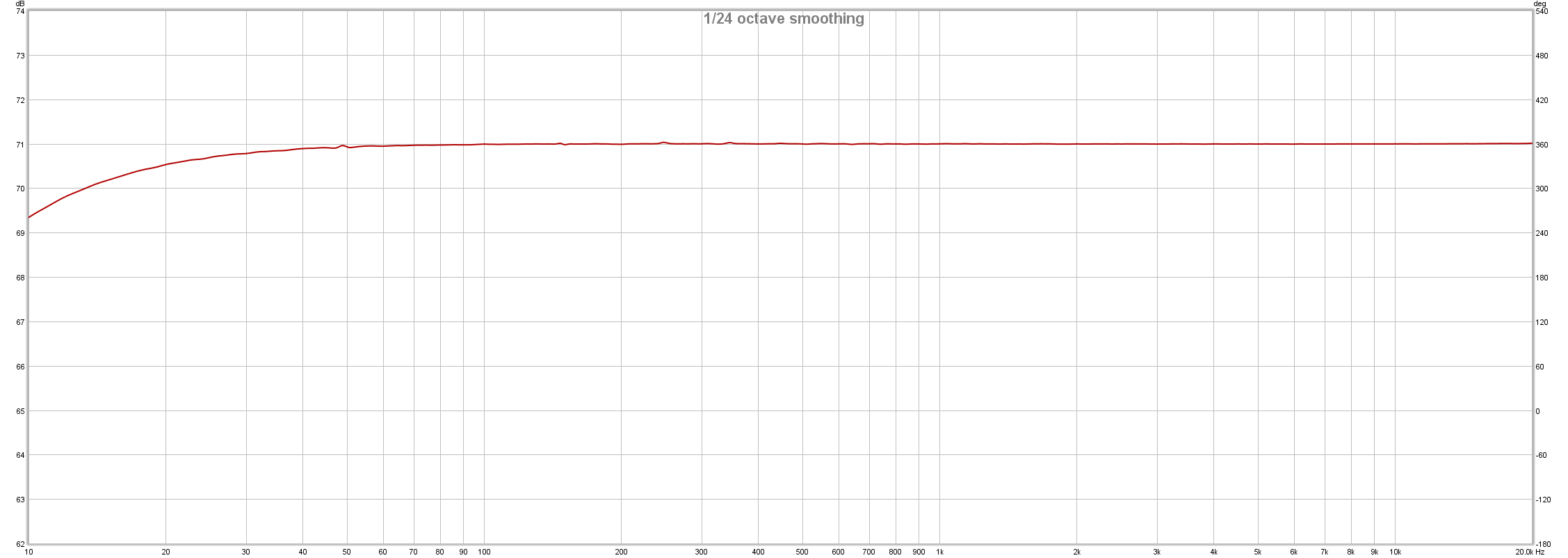
But other than those little niggles, I honestly am really enjoying the Little Bear.
So, when we look at a frequency response graph of the B4-X, what’s the first thing we see? The frequency response is essentially ruler flat between 20Hz and 20kHz with just a mere 0.5dB of roll-off from about 70Hz down to 20Hz.
But now let’s take a look at the distortion.
I should first say that the equipment I’m using to perform these frequency sweeps and measurements are not calibrated other than using a basic loopback calibration to compensate for the characteristics of the input and output devices. So, I don’t expect them to be totally accurate, especially when it comes to the distortion measurements.
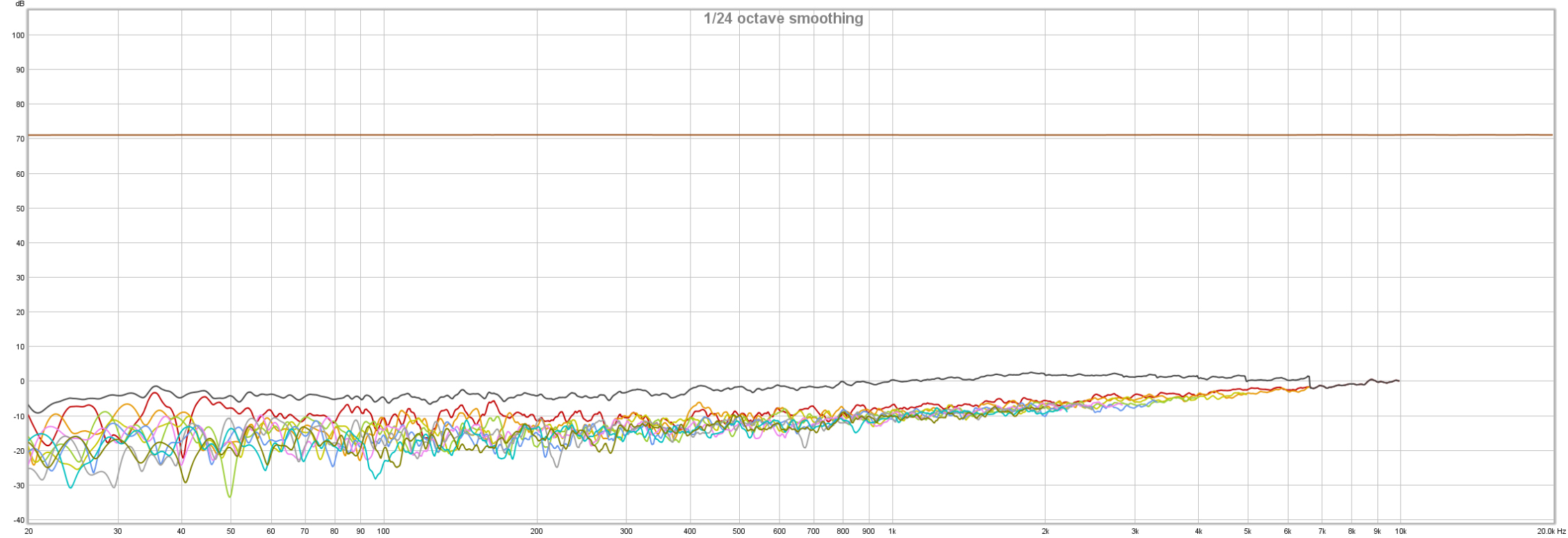
Having said that, this method is at least consistent, and that’s enough to make just some basic comparisons. But again, take the absolute accuracy with a pinch of salt.Right, so getting back to the distortion, the first image is that of the Micro iDSD Black Label. We can see that all of the varying orders of distortion are all pretty much muddled up and criss-crossing over each other.
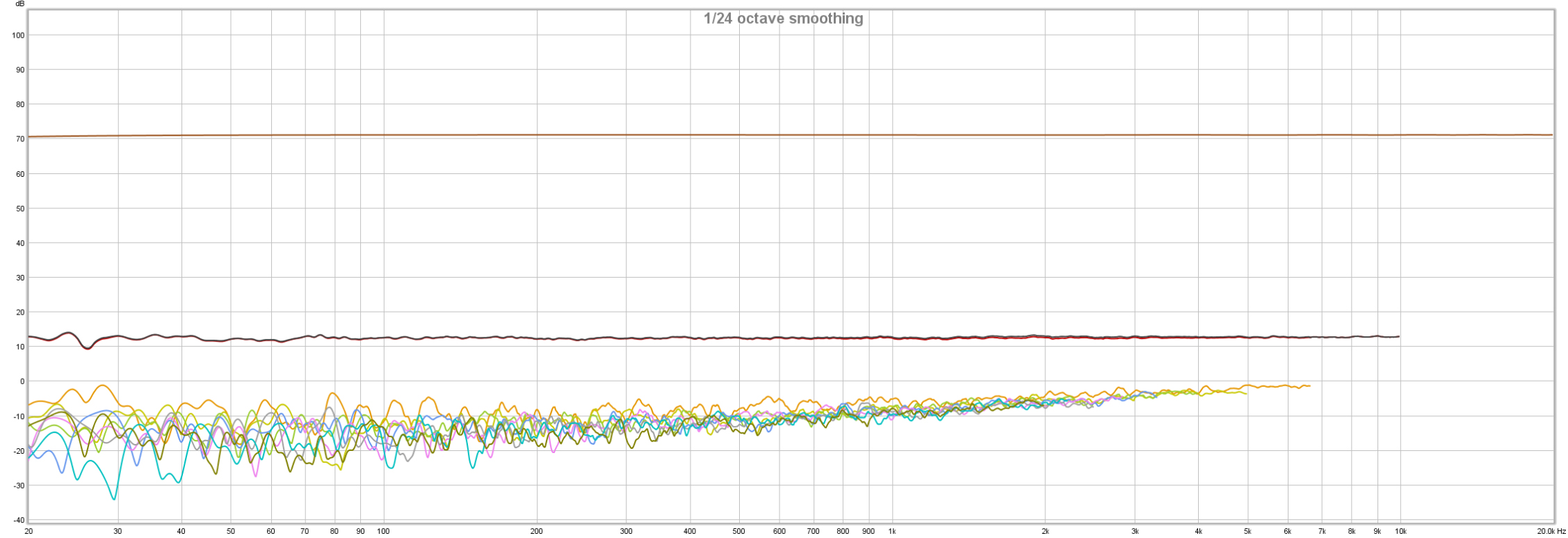
But now let’s take a look at what we get from the B4-X.As we can see there is a fair amount more distortion here, but the more important thing to note is that it’s practically all 2nd order harmonic distortion – the good kind.
Odd order harmonics remain virtually identical to those measured from the Micro iDSD BL with just a bit more 3rd order harmonics at those really low sub-bass frequencies.
So, what we can take away from this is that the B4-X is doing its job, and it seems to be doing it in the right manner and by just the right amount.
Value

At the end of the day, trying to consider how much value a product holds can differ by quite a large margin from one person to the next. People who don’t care about tube amplifiers will likely not give this Little Bear even a second glance. And that’s perfectly OK. Objectively, this is a device which adds distortion to the signal, which is entirely undesirable for many reasons and purposes.
But, then we also do get several groups of people who absolutely love that feeling of nostalgia and that touch of sweetness that tube-based systems give them. Then there are others who might be new-comers and are perhaps just a little curious about what it is about tubes that others find so fascinating.
And I think if you fall into either one of those camps, especially the former, then you will likely enjoy the B4-X.
At a price of just $100 (excluding shipping and/or taxes) it’s not something that’ll break the bank if you end up not liking it. The fact that it’s capable of delivering a fair amount of power into both a single-ended and a balanced connection is also a nice added bonus.
All in all, the B4-X just serves as a fun and, at the very least, acceptable little portable tube amp.

